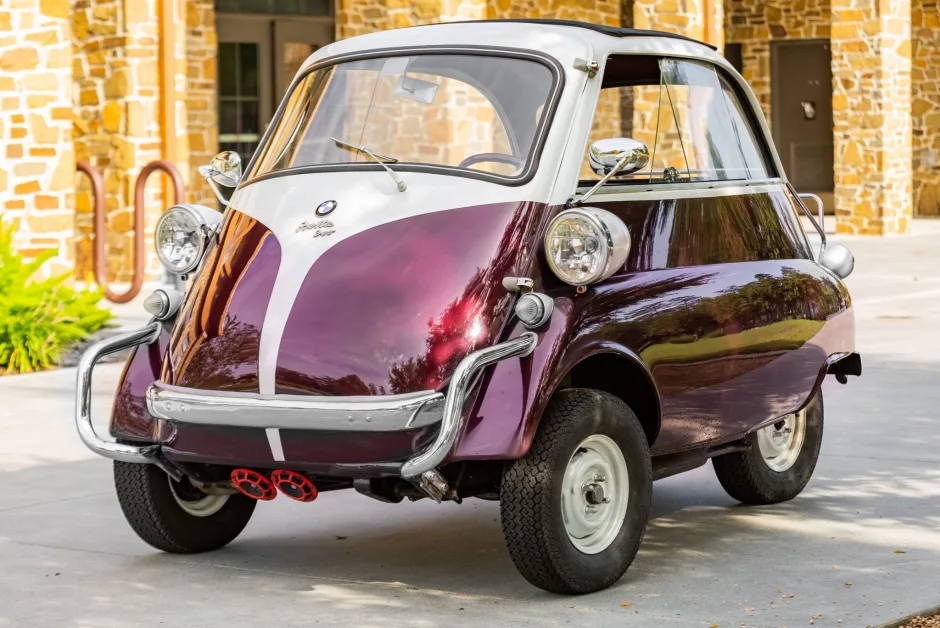
The 1958 BMW Isetta is an embodiment of resilience, economic recovery, and innovation, forever etched into the annals of automobile history. This tiny car, which played a significant role in revitalizing the post-war automotive industry in Europe, specifically in Germany, continued to evolve and thrive in 1958.
History:
The Isetta story began in Italy with Renzo Rivolta, the head of the Iso company, who initially manufactured refrigerators before moving into motor scooters and then cars. The original Isetta design was an Italian brainchild, a microcar intended to provide a cost-effective transportation solution in a period marked by economic recovery.
Recognizing its potential, BMW licensed the design and launched its version in 1955. BMW significantly refined the car, replacing the two-stroke engine with their own four-stroke motorcycle engine. The BMW Isetta rapidly gained popularity due to its affordability, reliability, and excellent fuel efficiency.
As the 1958 model year rolled in, the Isetta had already left a significant imprint on the automobile industry. It had established itself as a vehicle that not only represented recovery but also demonstrated that compact and efficient cars could be both practical and popular. It was during this period that the Isetta saw its production and sales peak, becoming a beacon of affordable mobility.
Specifications:
Engine: The 1958 BMW Isetta continued to use the same single-cylinder, four-stroke, 247cc motorcycle engine. Positioned at the rear, this air-cooled engine generated 12 horsepower at 5800 rpm.
Performance: The Isetta’s performance was more about efficiency than speed. It could achieve a top speed of approximately 53 mph (85 km/h), quite adequate for the city drives it was primarily designed for. However, the Isetta’s significant selling point was its exceptional fuel efficiency, consuming around 3 liters per 100 kilometers, making it a highly economical choice.
Body & Chassis: The 1958 BMW Isetta continued with its distinctive design, featuring the characteristic egg-shape and front-opening door. The compact dimensions – 2.29 meters long and 1.37 meters wide – allowed for easy parking and maneuverability through narrow streets. It was a two-seater, offering a surprisingly comfortable cabin for its size.
Suspension & Brakes: The Isetta employed an independent front suspension with a leading arm and coil springs. The rear had a semi-elliptical leaf spring. Drum brakes were fitted on all wheels, which were efficient for the vehicle’s speed and weight.
Further Into the History:
BMW had begun production of the Isetta in 1955, after acquiring the license from the Italian company Iso SpA. However, BMW didn’t merely replicate the Italian design; instead, they imbued the car with a unique German touch. BMW replaced the original two-stroke engine with its own four-stroke motorcycle engine, resulting in improved reliability and performance.
The BMW Isetta quickly became a popular choice among consumers due to its affordability, dependability, and impressive fuel economy. As 1958 approached, the Isetta’s success was soaring. The vehicle had proved itself as more than just an economical runaround; it was a symbol of resilience and economic recovery in a region still reeling from the effects of World War II.
Even though the Isetta was a small car in physical terms, it held a much larger place in BMW’s history. During the early 1950s, BMW had been on the brink of bankruptcy, and the Isetta played a significant role in pulling the company back from the precipice. By the time the 1958 model rolled off the production line, the Isetta had become an integral part of BMW’s identity and a beacon of the company’s recovery.
Digging Deeper Into the Specifications:
Engine: The 1958 BMW Isetta retained the same 247cc, single-cylinder, four-stroke motorcycle engine that had powered previous models. Despite its modest size, this engine was robust and reliable, producing 12 horsepower at 5800 rpm. The engine’s location alongside the rear wheel was a distinctive characteristic of the Isetta’s design.
Performance: The Isetta was never intended to be a speed demon. It was designed for practicality and economy, not high performance. The vehicle could reach a top speed of around 53 mph (85 km/h), which was more than adequate for urban driving and short commutes. However, the Isetta’s real strength lay in its fuel economy. With an estimated consumption of around 3 liters per 100 kilometers, it offered impressive fuel efficiency that set it apart from many of its contemporaries.
Body & Chassis: The design of the 1958 BMW Isetta remained largely unchanged from previous models. The vehicle’s compact, egg-shaped design, coupled with the distinctive front-opening door, made it unique in the automotive market. Despite its compact dimensions, the Isetta offered a comfortable interior that could accommodate two adults.
Suspension & Brakes: The Isetta utilized an independent front suspension featuring a leading arm and coil springs. At the rear, a semi-elliptical leaf spring was used. The vehicle was equipped with drum brakes on all wheels, offering efficient stopping power for its size and performance.
In conclusion, the 1958 BMW Isetta embodies a period of resilience and innovation in automotive history. Its story is more than just the tale of a small, economical car. It represents a turning point in BMW’s history, highlighting the crucial role that ingenuity and adaptability can play in overcoming challenges. Despite its diminutive size, the Isetta left an indelible mark on the automotive landscape and continues to be remembered fondly by car enthusiasts worldwide.
